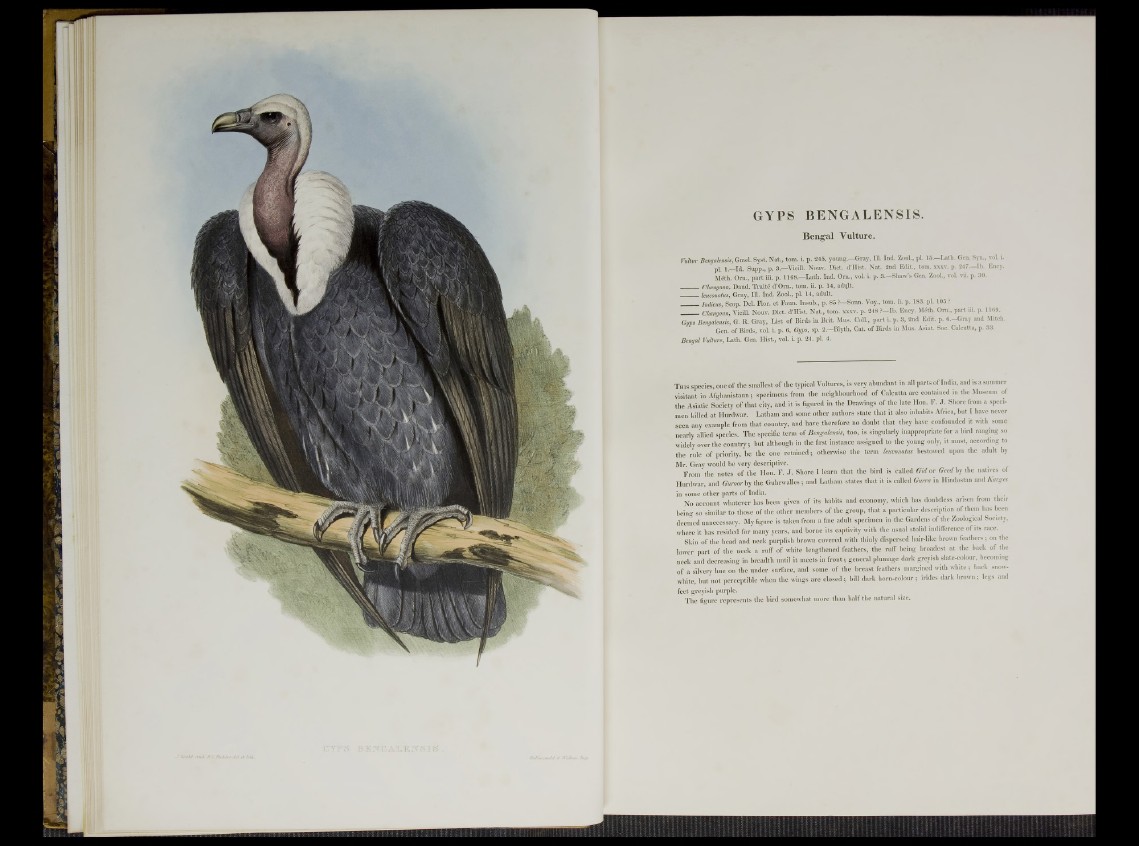
gWgÁ
GYPS BEN GALEN SI S.
Bengal Vulture.
VuUur Bentjalmsis, Gmel. Syst Nat., tom. i. p. 245, young.—Gray, 111. Ind. Zool., pi. 15.—Lath. Gen. Syn., vol. i.
pi. I.—Id. Supp., p. 3 —Yieill. Nouv. Diet. d'Hist. Nat. 2nd Edit., tom. xxxv. p. 247.—Ib. Ency.
Meth. Orn., p artiii. p. 1168.—Lath. Ind. O m , vol. i. p. 3.—Shaw’s Gen. Zool., vol. vii. p. 30.
Changoim, Daud. Traite d’Om., tom. ii. p. 14, adijlt.
leuconotus, Gray, 111. Ind. Zool., pi. 14, adult.
Indicus, Scop. Del. Elor. et Faun. Insub., p. 85 ?—Sonn. Voy., tom. ii. p. 183. pi. 105 ?
Changom, Vieffl. Nouv. Diet. d’Hist. Nat., tom. xxxv. p. 248 ?—Ib. Ency. Meth. Om., part iii. p. 1169.
Gyps Baigalensis, G. R. Gray, List of Birds in Brit. Mus. Coll., p art i. p. 3, 2nd Edit. p. 6 ,-G ray and Mitch.
Gen. of Birds, vol. i. p. 6, Gyps, sp. 2.—Blyth, Cat. of Birds in Mus. Asiat. Soc. Calcutta, p. 33.
Bengal Vulture, Lath. Gen. H is t, voL i. p. 24. pi. 4.
T h is species, one o f the smallest of the typical Vultures, is very abundant in all parts of India, and is a summer
visitant in Afghanistaun ; specimens from the neighbourhood of Calcutta are contained in the Museum of
the Asiatic Society of that city, and it is figured in the Drawings of the late Hon. F. J. Shore from a specimen
killed at Hurdwar. Latham and some other authors state that it also inhabits Africa, but I have never
seen any example from that country, and have therefore no doubt that they have confounded it with some
nearly allied species. The specific term of Bengalensis, too, is singularly inappropriate for a bird ranging so
wid ely over the country; but although in the first instance assigned to the young only, it must, according to
the rule of priority, be the one retained; otherwise the term leuconotus bestowed upon the adult by
Mr. Gray would be very descriptive.
From the notes of the Hon. F. J. Shore I learn that the bird is called Gill or Geed by the natives of
Hurdwar, and GWoorby the Guhrwalies; and Latham states that it is called Gmra in Hindostán and Kurges
in some other parts of India.
No account whatever has been given of its habits and economy, which has doubtless arisen from their
being so similar to those of the other members of the group, that a particular description of them has been
deemed unnecessary. My figure is taken from a fine adult specimen in the Gardens of the Zoological Society,
where it has resided for many years, and borne its captivity with the usual stolid indifference of its race.
Skin of the head and neck purplish brown covered with thinly dispersed hair-like brown feathers; on the
lower part of the neck a ruff of white lengthened feathers, the ruff being broadest at the back of the
neck and decreasing in breadth until it meets in front; general plumage dark greyish slate-colour, becoming
of a silvery hue on the under surface, and some of the breast feathers margined with white; back snow-
white, hut not perceptible when the wings are closed; bill dark horn-colour; irides dark brown; legs and
feet greyish purple.
The figure represents the bird somewhat more than half the natural size.